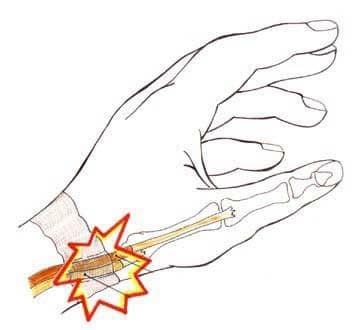What is Tenosynovitis or DeQuervain’s Tendinitis?

What causes tenosynovitis?
It is often noticed after excessive activity involving repeated lifting and/or side-to-side motion of the wrist. This is due to irritation and inflammation of two tendons at a point where they run through a very tight channel (“the first dorsal compartment”) from the forearm to the thumb. Many people have two small separate channels for the tendons and are particularly predisposed to this problem.
What can I do to reduce pain from Tenosynovitis / DeQuervain’s Tendinitis?
- Avoid wrist positions and activities which are painful, if possible.
- Ice the area which is most swollen and tender for 5 – 15 minutes.
- Use non-steroidal anti-inflammatory medication (NSAID), such as arcoxia, ibuprofen, naprosyn, or diclofenac. Check with a orthopaedic specialist regarding possible side effects and drug interactions.
- Wear a splint or brace which supports both the wrist and the thumb.
What can a physiotherapist do to help?
- Provide a variety of hand splints to support the thumb and the wrist.
- Help identify aggravating activities and suggest alternative postures.
- Massage, heat, ice, and other treatments aimed at making the area more comfortable.
What can an orthopaedic specialist do to help?
- Confirm that you have tenosynovitis.
- Prescribe stronger NSAID medication or cortisone-type medication.
- Prescribe hand therapy and/or a custom prescription splint.
- Administer a cortisone / lignocaine injection into the area of the most irritation.
- Perform surgery to enlarge the tight channel so the tendons no longer chafe.
How successful are the treatments for Tenosynovitis / DeQuervain’s Tendinitis?
Many people with mild symptoms will improve with anti-inflammatory medication and avoiding painful activities, especially if the problem has developed due to unaccustomed strenuous activities. It is less likely to resolve if it is related to light repetitive work activities.
A cortisone / lignocaine injection into the sore area provides temporary relief lasting a few months. The injection might provide permanent relief for as many as two out of three people with this problem.
DeQuervain’s Tendinitis surgery helps over four out of five people with this problem, but as many as one out of five may experience numbness on the back of the hand or tenderness of the scar after the surgery.
Make an appointment
Make an appointment to consult an orthopaedic specialist. Select "Specialist Appointment". Under Specialist Appointment Details, select "Orthopaedic Surgery" or "Pain Management".
Make an enquiry. We will get back to you within 2 working days. You can reach us at 6311 2310.